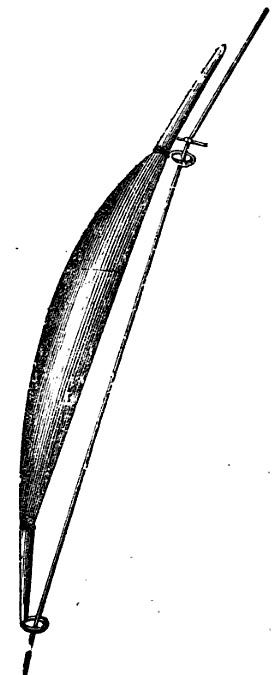I was reading something recently that referenced "Nottingham" style fishing. I had to look it up, and found a really nice description in The North Punjab Fishing Club Anglers' Handbook by G.H. Lacy and Dr. E. Cretin (3rd Edition-1895) of all places. Here is their description of the unique Nottingham float, which predates today's "slip bobbers" by over a hundred years.
If however a float is used while fishing with atta, or, indeed, in any kind of bottom fishing for Mahseer, the "Nottingham style" of fishing is recommended. Doubtless few fishermen in India know exactly what this means.

I will endeavour to describe it. The peculiarities of the float used in this style of fishing are as follows:—It is curved, or bow-shaped, instead of being straight. The bottom ring js at right angles with, instead of being in the same line with the wooden shaft. A quill cap is not used but a ring is fastened just at the shoulder of the cork body of the float, projecting from it through which the line can pass freely. The float can therefore travel up and down the line, and is not fixed at any particular spot.
A diagram of this float is given marginally, which will make the above clear. On your gut cast at the " depth" you wish to fish, a small piece of gut or fine wire about a quarter of an inch long is knotted crossways, and above the float. The result is that the line can run down through the float to this point, the float remaining stationary. The great advantage of this is that on the line being withdrawn from the water, the float falls, or slides down on to the shot (which should be bigger than the bottom ring of the float), and at this point forms an additional weight near the bait, by means of which very long casts can be made. When, after making your casts, the bait and float reach the water, give out your line freely; the weight of the shot and bait, with a little assistance from the rod, will pull the gut through the loops or rings on the float until it is checked by the small cross piece of gut or wire at the required depth.
You can by this means fish very deep, say ten feet or more, more easily than by the ordinary way, and you can cast further, both of which are special advantages in Indian waters, whether tanks or rivers! Another advantage is that you strike the fish direct, and have not got to half• pull the float out of the water, thus causing a disturbance, as is done in the ordinary way. The above style of float fishing is recommended for every kind of Indian bottom fishing except for Labeos, and if any one cares to try it he will find it a great advantage, that is, if he cares to use a float while fishing with atta, worm, etc., as a bait.
-- Dr. Todd
No comments:
Post a Comment